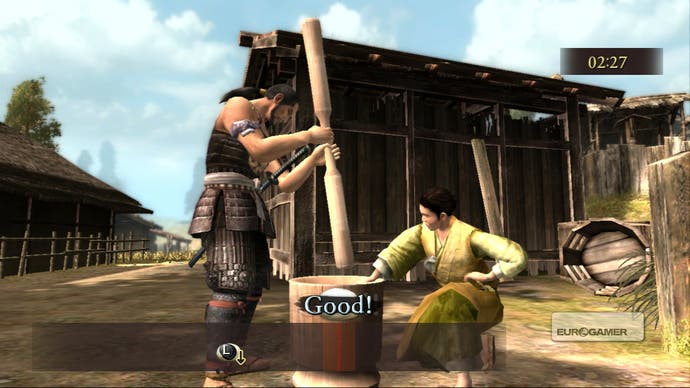Way of the Samurai 3
Ronin on empty.
During one playthrough, I grew tired of life as a bandit and killed Ouka Clan's boorish leader. Once my treachery was discovered, I was attacked by Ouka loyalists wherever I went. After a few days, however, they apologised and made me their new leader. Then Fujimori Clan attacked our castle, and I carved a bloody swathe through their ranks thanks to the awesome weapon I inherited from my predecessor.
After hundreds of kills, the game abruptly cut to a closing text crawl saying I'd died in battle - even though I clearly hadn't, and could quite frankly have continued slaughtering soldiers for hours. The game had decided which path I was on, however, and from that point my demise was unavoidable, regardless of my actions on the battlefield.
A large part of the blame for this woolly lack of cohesion must fall to a game engine that feels like it's been dusted off from the PS2 era. The story may be flexible but the tools used in the telling are rigid and shallow. Dialogue appears in silent word balloons, floating crudely above a handful of character models, while cut-scenes groan with scripting that is either poorly translated or badly written, or both. Conversation options are limited to two or three inane responses, which make it hard to tell what sort of reaction you're giving.
Some of this can be put down to a lack of cultural context, but often it's clearly just stiff design. There's no room for subtlety, and the game often misreads your intentions.
The outdated code eats away even more at the basics of the genre, rendering exploration and combat unpleasantly clunky. The game is made up of just eight small areas, each filled with repeated scenery and crude textures. Clipping issues are a constant problem, and this only becomes more pronounced during fights, as arms and legs vanish inside rocks and walls, or merge and overlap in Cronenberg configurations.

Collision detection is therefore predictably skewed, and it's depressingly common to see swords pass through enemies without leaving a scratch. Get more than a few enemies on screen at a time and the frame-rate plummets. For a game based around warriors famed for their poise and grace, the shoddy mechanics do little to immerse you in their mindset.
That's a pity, since trapped inside this rusty cage of antique coding there's a game of considerable depth. Different combat stances, different sword types, different skills and combinations of weapon parts; all work together to offer a remarkably detailed representation of a distinctive form of fighting. There are echoes of Squaresoft's Bushido Blade, something based on more than just swords but the culture around them as well, yet the game itself is simply too clumsy to allow these nuances to bear fruit.
While Acquire's series wins in terms of quantity where alternate endings are concerned, it's fatally undermined by its prehistoric game engine, the flat lifelessness of the story seemingly in inverse proportion to the number of routes through it. Way of the Samurai was impressive on the PS2 eight years ago but it's remained stagnant, offering the same scenario with the same technology to an audience that has grown to expect more.
Its best ideas have already been borrowed and improved by the likes of Fable II, Heavy Rain, Mass Effect and Dragon Age, all of which offer less narrative wiggle room but do so in compelling worlds populated by rounded characters. Way of the Samurai 3 wastes too much energy juggling the numerous ways it can end your story and not nearly enough on making the journey to get there worthwhile.








